Investigating the Potentials of Rainwater Harvesting System in Melbourne and Adelaide
Added on 2023-06-10
41 Pages11705 Words87 Views
POTENTIALS OF RAINWATER HARVESTING 1
INVESTIGATING THE POTENTIALS OF THE RAINWATER HARVESTING SYSTEM IN
MELBOURNE AND ADELAIDE
Name
Course
Professor
University
City/state
Date
INVESTIGATING THE POTENTIALS OF THE RAINWATER HARVESTING SYSTEM IN
MELBOURNE AND ADELAIDE
Name
Course
Professor
University
City/state
Date
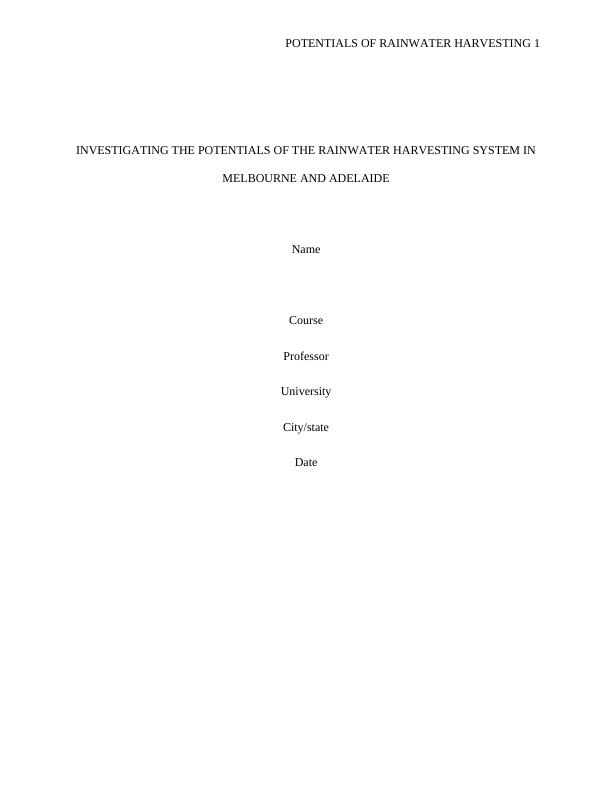
POTENTIALS OF RAINWATER HARVESTING 2
Abstract
Many countries are facing the problem of water scarcity, which is expected to rise in the coming
years due to factor such as population growth and climate change. Australia is the driest
continent in the world and most of its cities are affected by water shortage. As a result, the need
for alternative water sources in Australian cities cannot be overemphasized. This study will focus
on determining the potential of rainwater harvesting system in Melbourne and Adelaide. This
will be achieved by creating a computerized simulation model with the ability to estimate the
amount of rainwater that can be harvested per unit roof area in Melbourne and Adelaide. The
amount of rainwater harvested depends on annual rainfall amount, and the type, size and
efficiency of rainwater harvesting systems used. Many Australian cities have turned to rainwater
harvesting systems as an alternative source of water to supplement mains supply. A water
balance model for Melbourne and Adelaide will be created and used to determine the percentage
of water demand that can be supplied with rainwater harvesting systems in the two cities. It is
expected that rainwater harvesting systems in Melbourne and Adelaide account for relatively
small percentage of water consumption in Melbourne and Adelaide. However, this model can be
used to determine ways on how to increase the amount of rainwater harvested.
Abstract
Many countries are facing the problem of water scarcity, which is expected to rise in the coming
years due to factor such as population growth and climate change. Australia is the driest
continent in the world and most of its cities are affected by water shortage. As a result, the need
for alternative water sources in Australian cities cannot be overemphasized. This study will focus
on determining the potential of rainwater harvesting system in Melbourne and Adelaide. This
will be achieved by creating a computerized simulation model with the ability to estimate the
amount of rainwater that can be harvested per unit roof area in Melbourne and Adelaide. The
amount of rainwater harvested depends on annual rainfall amount, and the type, size and
efficiency of rainwater harvesting systems used. Many Australian cities have turned to rainwater
harvesting systems as an alternative source of water to supplement mains supply. A water
balance model for Melbourne and Adelaide will be created and used to determine the percentage
of water demand that can be supplied with rainwater harvesting systems in the two cities. It is
expected that rainwater harvesting systems in Melbourne and Adelaide account for relatively
small percentage of water consumption in Melbourne and Adelaide. However, this model can be
used to determine ways on how to increase the amount of rainwater harvested.
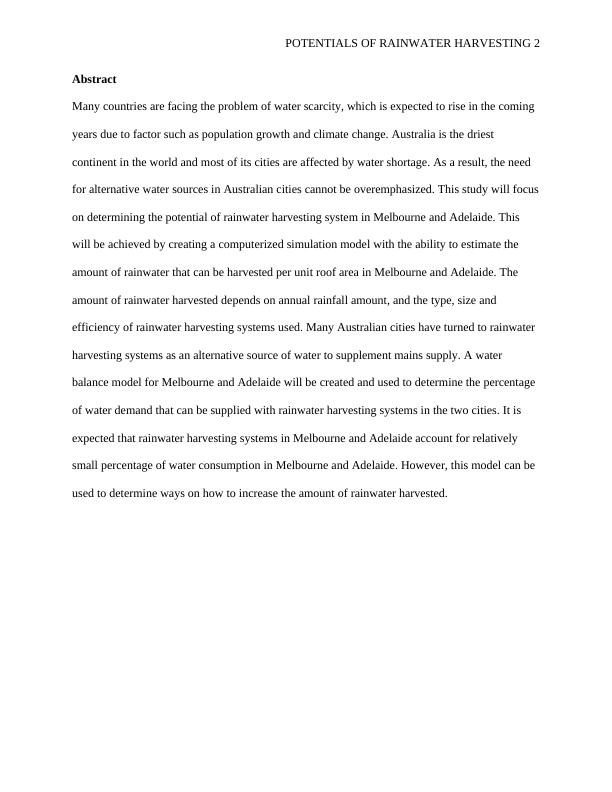
POTENTIALS OF RAINWATER HARVESTING 3
Table of Contents
Abstract......................................................................................................................................................2
1. Introduction.......................................................................................................................................4
1.1. Problem Statement....................................................................................................................5
1.2. Aim..............................................................................................................................................5
1.3. Objectives...................................................................................................................................6
1.4. Research Justification................................................................................................................6
1.5. Melbourne Rainfall....................................................................................................................7
1.6. Adelaide Rainfall.......................................................................................................................9
2. Literature Review............................................................................................................................11
2.1. Components of a rainwater harvesting system......................................................................12
2.2. Functions of rainwater harvesting systems............................................................................12
2.3. Types of rainwater harvesting systems..................................................................................13
2.4. Types of rainwater storage tanks............................................................................................14
2.5. Advantages and Disadvantages of Rainwater Harvesting Systems......................................20
2.5.1. Advantages.......................................................................................................................20
2.5.2. Disadvantages...................................................................................................................22
2.6. Estimation of Harvested Rainwater Volume.........................................................................23
2.7. Water Balance Model..............................................................................................................25
3. Methodology.....................................................................................................................................28
3.1. Study area.................................................................................................................................28
3.1.1. Melbourne........................................................................................................................28
3.1.2. Adelaide............................................................................................................................29
3.2. Google Earth............................................................................................................................29
3.3. Calculation of Roof Surface Area...........................................................................................30
3.4. Digitalized Areas Corrections.................................................................................................30
3.5. Estimation of Potential Volumes of Harvested Rainwater...................................................31
3.6. Estimation of Water Demand.................................................................................................31
3.7. Comparing Water Demand and Supply Gap........................................................................33
4. Conclusion........................................................................................................................................33
References................................................................................................................................................36
Table of Contents
Abstract......................................................................................................................................................2
1. Introduction.......................................................................................................................................4
1.1. Problem Statement....................................................................................................................5
1.2. Aim..............................................................................................................................................5
1.3. Objectives...................................................................................................................................6
1.4. Research Justification................................................................................................................6
1.5. Melbourne Rainfall....................................................................................................................7
1.6. Adelaide Rainfall.......................................................................................................................9
2. Literature Review............................................................................................................................11
2.1. Components of a rainwater harvesting system......................................................................12
2.2. Functions of rainwater harvesting systems............................................................................12
2.3. Types of rainwater harvesting systems..................................................................................13
2.4. Types of rainwater storage tanks............................................................................................14
2.5. Advantages and Disadvantages of Rainwater Harvesting Systems......................................20
2.5.1. Advantages.......................................................................................................................20
2.5.2. Disadvantages...................................................................................................................22
2.6. Estimation of Harvested Rainwater Volume.........................................................................23
2.7. Water Balance Model..............................................................................................................25
3. Methodology.....................................................................................................................................28
3.1. Study area.................................................................................................................................28
3.1.1. Melbourne........................................................................................................................28
3.1.2. Adelaide............................................................................................................................29
3.2. Google Earth............................................................................................................................29
3.3. Calculation of Roof Surface Area...........................................................................................30
3.4. Digitalized Areas Corrections.................................................................................................30
3.5. Estimation of Potential Volumes of Harvested Rainwater...................................................31
3.6. Estimation of Water Demand.................................................................................................31
3.7. Comparing Water Demand and Supply Gap........................................................................33
4. Conclusion........................................................................................................................................33
References................................................................................................................................................36
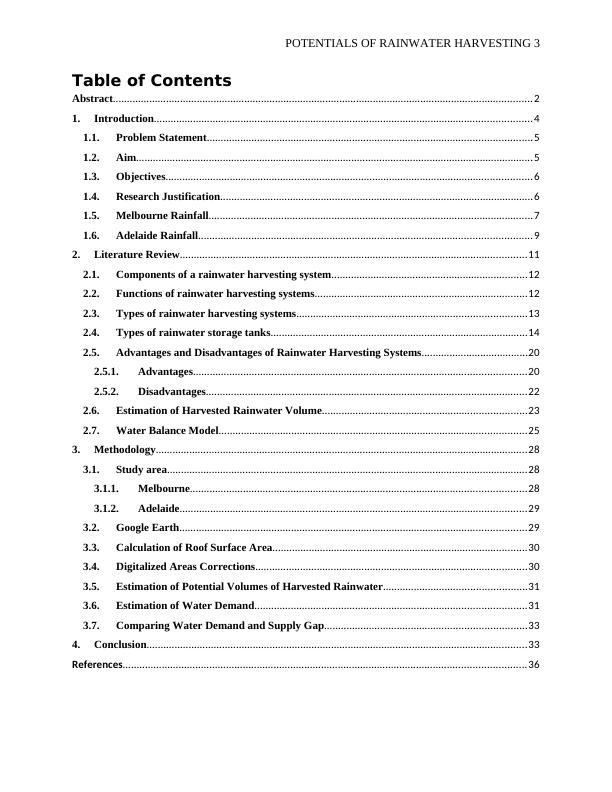
POTENTIALS OF RAINWATER HARVESTING 4
1. Introduction
Water scarcity is a problem that is already affecting over 40% of the global population
(Reporter, 2018). This problem is expected to rise because of population growth, global warming
and climate change in general (Adugna, et al., 2018). Cities, which are already hosting about
55% of the world’s population (and this is expected to reach 68% by 2050) (Meredith, 2018), are
the most affected as the increasing urban population puts pressure on water reserves. The
reserves are also already stretched due to too much waste and too little rain (SBS News, 2018).
Australia is the driest continent on earth (Preston, 2008) hence the need for alternative water
harvesting systems and saving measures in the country is inevitable. Some of these include:
water conservation, water recycling, rainwater harvesting and desalination. This research focuses
on the potential of rainwater harvesting system in Melbourne and Adelaide.
Australia is the world’s driest inhabited continent, characterized by the lowest volume of
water in rivers, smallest area of perpetual wetlands and lowest run-off. Its climate is slowly
drying and has very high variability (Australian Government, 2018). Th highly variable climate
is due to atmospheric variation and different currents. The country has regular cycles of floods
and droughts that result in extremely variable water storage volumes especially in its major dams
(van der Sterren, et al., 2010). Human activities are continuously exerting pressure on marine
environments in the country, making water crisis a national problem.
Melbourne and Adelaide are among Australian cities that are feeling water stress
(Wright, 2017). Within a decade, these cities could experience water crisis. Water scarcity s
when there is <100 m3 deficit per capita per annum while water stress is when there is <1,700 m3
deficit per capita per annum (Taffere, et al., 2016). Melbourne’s water storage now stands at
58.4% from 62.1% the previous year, while Adelaide’s water storage is at 46.2% from last year’s
1. Introduction
Water scarcity is a problem that is already affecting over 40% of the global population
(Reporter, 2018). This problem is expected to rise because of population growth, global warming
and climate change in general (Adugna, et al., 2018). Cities, which are already hosting about
55% of the world’s population (and this is expected to reach 68% by 2050) (Meredith, 2018), are
the most affected as the increasing urban population puts pressure on water reserves. The
reserves are also already stretched due to too much waste and too little rain (SBS News, 2018).
Australia is the driest continent on earth (Preston, 2008) hence the need for alternative water
harvesting systems and saving measures in the country is inevitable. Some of these include:
water conservation, water recycling, rainwater harvesting and desalination. This research focuses
on the potential of rainwater harvesting system in Melbourne and Adelaide.
Australia is the world’s driest inhabited continent, characterized by the lowest volume of
water in rivers, smallest area of perpetual wetlands and lowest run-off. Its climate is slowly
drying and has very high variability (Australian Government, 2018). Th highly variable climate
is due to atmospheric variation and different currents. The country has regular cycles of floods
and droughts that result in extremely variable water storage volumes especially in its major dams
(van der Sterren, et al., 2010). Human activities are continuously exerting pressure on marine
environments in the country, making water crisis a national problem.
Melbourne and Adelaide are among Australian cities that are feeling water stress
(Wright, 2017). Within a decade, these cities could experience water crisis. Water scarcity s
when there is <100 m3 deficit per capita per annum while water stress is when there is <1,700 m3
deficit per capita per annum (Taffere, et al., 2016). Melbourne’s water storage now stands at
58.4% from 62.1% the previous year, while Adelaide’s water storage is at 46.2% from last year’s
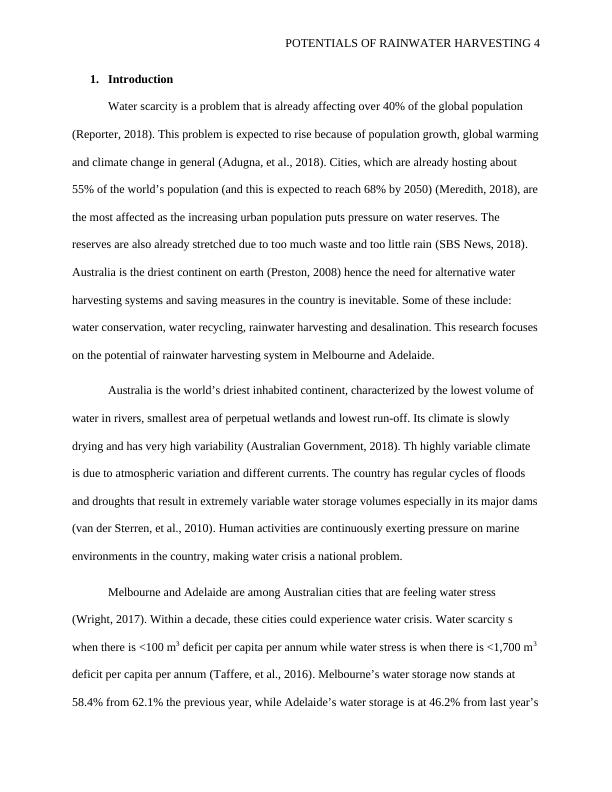
POTENTIALS OF RAINWATER HARVESTING 5
56.6% (Australian Government - Bureau of Meteorology, 2018). The continuing water shortage
in Melbourne and Adelaide is mainly caused by population growth and climate change
(Chalkley-Rhoden, 2017). Therefore the need for alternative water harvesting system in the two
cities is inevitable.
1.1. Problem Statement
Water plays a pivotal role in people’s day-to-day activities. Every government wishes to
supply citizens with adequate water for domestic, agricultural and industrial use. Adequate water
supply has positive impacts on people’s quality of life, environmental conservation and
economic growth. However, Australia, which is the world’s driest continent, is facing water
shortage problem. Melbourne and Adelaide are among the most affected cities. This problem is
mainly caused by climate change and the rapidly increasing urban population (Lee, et al., 2017).
As climate change intensifies and urban population continues to grow, water demand in both
cities will soon outstrip supply. As a result, water crisis is looming. However, this problem can
be alleviated by exploring alternative water sources. This study proposes to investigate the
potential of rainwater harvesting systems for increasing water supply in Melbourne and
Adelaide. The study will entail carrying out comprehensive investigation so as to create a water
balance model that can determine if rainwater harvesting systems is a reliable alternative for
water shortage in the two cities.
1.2. Aim
This study aims at investigating the potential of rainwater harvesting systems in
Melbourne and Adelaide, so as to determine if these systems can be used to alleviate water
scarcity in the two cities. This will be achieved by creating individual water balance models for
Melbourne and Adelaide.
56.6% (Australian Government - Bureau of Meteorology, 2018). The continuing water shortage
in Melbourne and Adelaide is mainly caused by population growth and climate change
(Chalkley-Rhoden, 2017). Therefore the need for alternative water harvesting system in the two
cities is inevitable.
1.1. Problem Statement
Water plays a pivotal role in people’s day-to-day activities. Every government wishes to
supply citizens with adequate water for domestic, agricultural and industrial use. Adequate water
supply has positive impacts on people’s quality of life, environmental conservation and
economic growth. However, Australia, which is the world’s driest continent, is facing water
shortage problem. Melbourne and Adelaide are among the most affected cities. This problem is
mainly caused by climate change and the rapidly increasing urban population (Lee, et al., 2017).
As climate change intensifies and urban population continues to grow, water demand in both
cities will soon outstrip supply. As a result, water crisis is looming. However, this problem can
be alleviated by exploring alternative water sources. This study proposes to investigate the
potential of rainwater harvesting systems for increasing water supply in Melbourne and
Adelaide. The study will entail carrying out comprehensive investigation so as to create a water
balance model that can determine if rainwater harvesting systems is a reliable alternative for
water shortage in the two cities.
1.2. Aim
This study aims at investigating the potential of rainwater harvesting systems in
Melbourne and Adelaide, so as to determine if these systems can be used to alleviate water
scarcity in the two cities. This will be achieved by creating individual water balance models for
Melbourne and Adelaide.
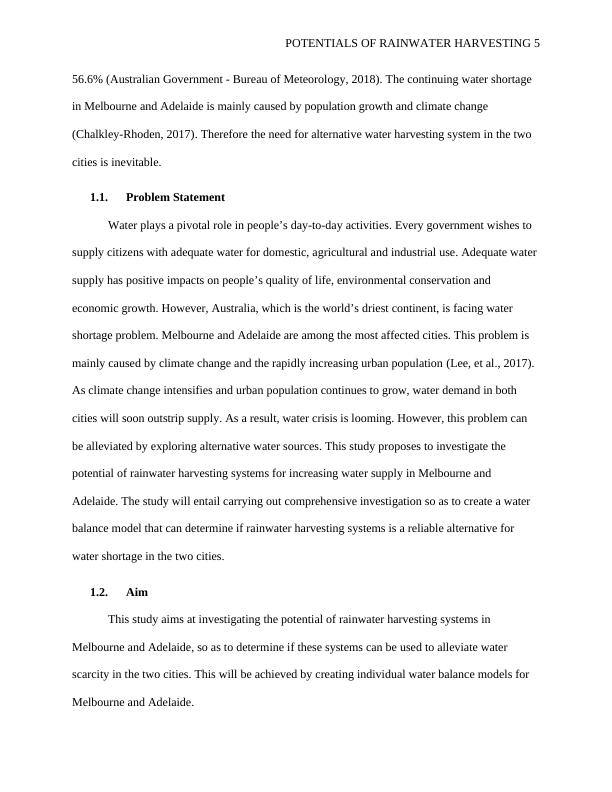
POTENTIALS OF RAINWATER HARVESTING 6
1.3. Objectives
The specific objectives of the study are:
To evaluate and predict the potential of rainwater harvesting in Melbourne and Adelaide
To determine the reliability of rainwater harvesting systems in Melbourne and Adelaide
To assess the effects of Australia’s climatic condition variation on the efficiency and
reliability of rainwater harvesting systems in Melbourne and Adelaide
To assess the amount of water used in Melbourne and Adelaide and determine if
rainwater harvesting systems are a feasible alternative for water scarcity
To create a water balance model for the cities of Melbourne and Adelaide.
1.4. Research Justification
Water is very important to life (Alexe & Toma, 2013); (Popkin, et al., 2010). According
to the United Nations, people have a right to safe and clean drinking water. The water also plays
a key role in attaining other human rights such as livelihoods and food (Hall, et al., 2014).
However, factors such as population growth, inefficient water practices and climate change have
resulted to global water scarcity. Australia is among the most affected countries (considering also
that it is the driest continent on earth). The focus of this paper is on two Australian cities:
Melbourne and Adelaide. These cities are already experiencing water shortage and water crisis is
looming. In the near future, water demand will surpass water supply. In order to protect the lives
of residents, protect the environment (biodiversity and ecosystems) and promote economic
growth of Melbourne and Adelaide, the need for alternative water sources cannot be
overemphasized. This research will be examining the potential of water harvesting systems as an
alternative source of water for Melbourne and Adelaide. The paper will use software to create a
model that can be used to estimate the volume of rainwater that can be harvested using different
1.3. Objectives
The specific objectives of the study are:
To evaluate and predict the potential of rainwater harvesting in Melbourne and Adelaide
To determine the reliability of rainwater harvesting systems in Melbourne and Adelaide
To assess the effects of Australia’s climatic condition variation on the efficiency and
reliability of rainwater harvesting systems in Melbourne and Adelaide
To assess the amount of water used in Melbourne and Adelaide and determine if
rainwater harvesting systems are a feasible alternative for water scarcity
To create a water balance model for the cities of Melbourne and Adelaide.
1.4. Research Justification
Water is very important to life (Alexe & Toma, 2013); (Popkin, et al., 2010). According
to the United Nations, people have a right to safe and clean drinking water. The water also plays
a key role in attaining other human rights such as livelihoods and food (Hall, et al., 2014).
However, factors such as population growth, inefficient water practices and climate change have
resulted to global water scarcity. Australia is among the most affected countries (considering also
that it is the driest continent on earth). The focus of this paper is on two Australian cities:
Melbourne and Adelaide. These cities are already experiencing water shortage and water crisis is
looming. In the near future, water demand will surpass water supply. In order to protect the lives
of residents, protect the environment (biodiversity and ecosystems) and promote economic
growth of Melbourne and Adelaide, the need for alternative water sources cannot be
overemphasized. This research will be examining the potential of water harvesting systems as an
alternative source of water for Melbourne and Adelaide. The paper will use software to create a
model that can be used to estimate the volume of rainwater that can be harvested using different
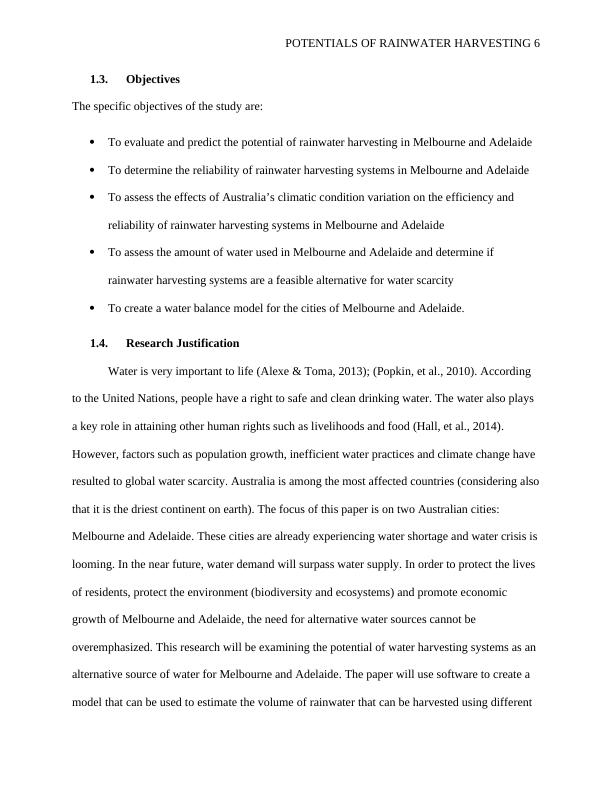
POTENTIALS OF RAINWATER HARVESTING 7
rainwater harvesting systems. This model can be used by the federal government, state
governments, local governments, companies and individuals to determine the most appropriate
type and size of water harvesting systems they can use to generate more water for various uses in
Melbourne and Adelaide. Most of the previous studies did not consider the specific
characteristics and variations of Melbourne and Adelaide, instead they created general models
for Australia, which does not provide accurate estimates for specific cities. This is because
rainwater harvesting is a site-specific source of water (Stout, et al., 2017). It is also worth noting
that the variability of Australian climatic conditions is very high hence the need to create specific
rainwater harvesting system models for each city. Findings from this research can be used by
policymakers in Melbourne and Adelaide to develop appropriate infrastructure and plans that
will promote use of rainwater harvesting systems thus increasing water supply in the two cities
and reducing overreliance on mains supply.
1.5. Melbourne Rainfall
Melbourne is located at an altitude of 35 m above sea level. Its climate is classified as
temperate oceanic (warm and temperate), and is known for its high variability due to
geographical location of the city. The city is located to the south hence it is affected by westerly
winds’ flow. These winds bring low pressure systems in different months of the year, which
causes climate variations. According to Koppen-Geiger climate classification system, the climate
of Melbourne is Cfb – a west coast marine climate (Denk, et al., 2013). Cfb represents a
generally humid climate with a sort dry summer. During mild winters, heavy precipitation occurs
due to presence of mid-latitude cyclones (PhysicalGeography.net, 2018). Koppen classification
system is classifies climate based on regions’ characteristics seasonalities and other multiple
variables (Chen & Chen, 2013).
rainwater harvesting systems. This model can be used by the federal government, state
governments, local governments, companies and individuals to determine the most appropriate
type and size of water harvesting systems they can use to generate more water for various uses in
Melbourne and Adelaide. Most of the previous studies did not consider the specific
characteristics and variations of Melbourne and Adelaide, instead they created general models
for Australia, which does not provide accurate estimates for specific cities. This is because
rainwater harvesting is a site-specific source of water (Stout, et al., 2017). It is also worth noting
that the variability of Australian climatic conditions is very high hence the need to create specific
rainwater harvesting system models for each city. Findings from this research can be used by
policymakers in Melbourne and Adelaide to develop appropriate infrastructure and plans that
will promote use of rainwater harvesting systems thus increasing water supply in the two cities
and reducing overreliance on mains supply.
1.5. Melbourne Rainfall
Melbourne is located at an altitude of 35 m above sea level. Its climate is classified as
temperate oceanic (warm and temperate), and is known for its high variability due to
geographical location of the city. The city is located to the south hence it is affected by westerly
winds’ flow. These winds bring low pressure systems in different months of the year, which
causes climate variations. According to Koppen-Geiger climate classification system, the climate
of Melbourne is Cfb – a west coast marine climate (Denk, et al., 2013). Cfb represents a
generally humid climate with a sort dry summer. During mild winters, heavy precipitation occurs
due to presence of mid-latitude cyclones (PhysicalGeography.net, 2018). Koppen classification
system is classifies climate based on regions’ characteristics seasonalities and other multiple
variables (Chen & Chen, 2013).
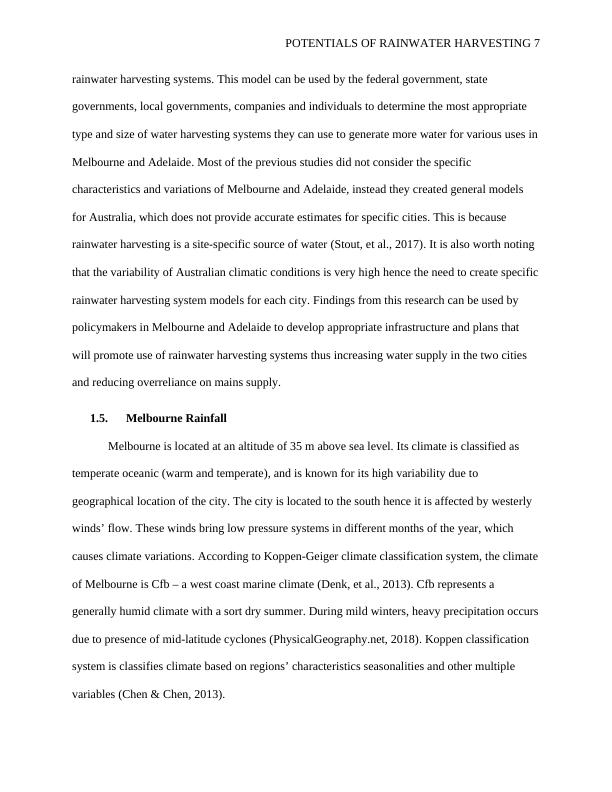
POTENTIALS OF RAINWATER HARVESTING 8
The climograph of Melbourne is as shown in Figure 1 below. The graph shows that
Melbourne receives significant amount of rainfall all year round, including the direst month. The
month with the lowest rainfall is February and March, which receives 44 mm each while the
month that receives the highest rainfall is October with 71 mm. The average annual rainfall is
666 mm while the average monthly rainfall is 55.5 mm. Generally, Melbourne does not receive
very abundant rainfall but the rainfall it receives is well distributed over the months
(Climatestotravel.com, 2018). The difference of rainfall received during the wettest and driest
months is 27 mm.
Figure 1: Climograph of Melbourne (Climate-Data.Org, (n.d.)b)
The warmest month of the year is February with an average temperature of 20.3°C
(February is also the month that receives the lowest rainfall) while the coldest month is July with
an average temperature of 9.4 °C (July is also the month that receives the highest rainfall). The
difference of temperature between the warmest and coldest months is 10.9 °C.
The climograph of Melbourne is as shown in Figure 1 below. The graph shows that
Melbourne receives significant amount of rainfall all year round, including the direst month. The
month with the lowest rainfall is February and March, which receives 44 mm each while the
month that receives the highest rainfall is October with 71 mm. The average annual rainfall is
666 mm while the average monthly rainfall is 55.5 mm. Generally, Melbourne does not receive
very abundant rainfall but the rainfall it receives is well distributed over the months
(Climatestotravel.com, 2018). The difference of rainfall received during the wettest and driest
months is 27 mm.
Figure 1: Climograph of Melbourne (Climate-Data.Org, (n.d.)b)
The warmest month of the year is February with an average temperature of 20.3°C
(February is also the month that receives the lowest rainfall) while the coldest month is July with
an average temperature of 9.4 °C (July is also the month that receives the highest rainfall). The
difference of temperature between the warmest and coldest months is 10.9 °C.
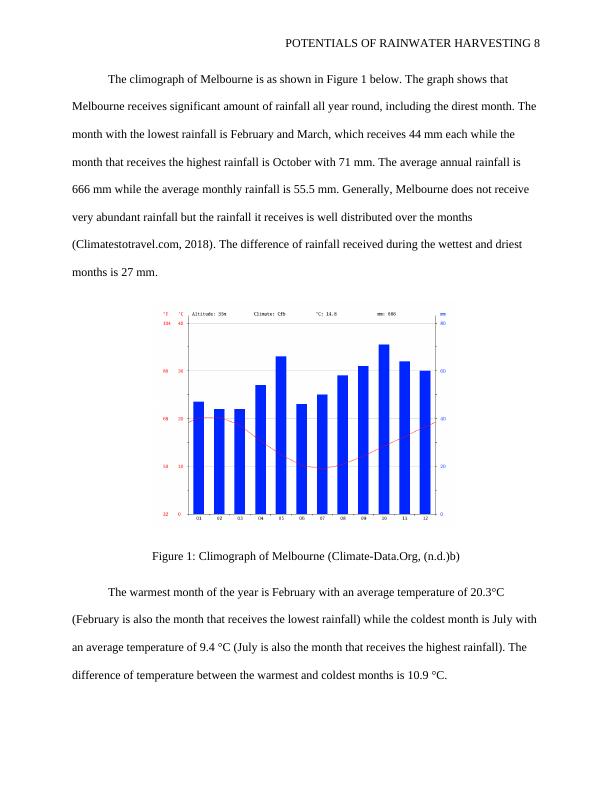
End of preview
Want to access all the pages? Upload your documents or become a member.
Related Documents
Effect of Climate Change on Rainwater Tanks Savings in Sydney, Australialg...
|16
|1000
|76
Rainwater Harvesting System Designlg...
|17
|2268
|34
Rainwater Harvesting in Sydney, Australialg...
|41
|14377
|97
Sustainable Groundwater Extraction and Infrastructure Designlg...
|52
|12703
|282
Smart Cities: Sustainable Urban Development through ICTlg...
|11
|4289
|69
